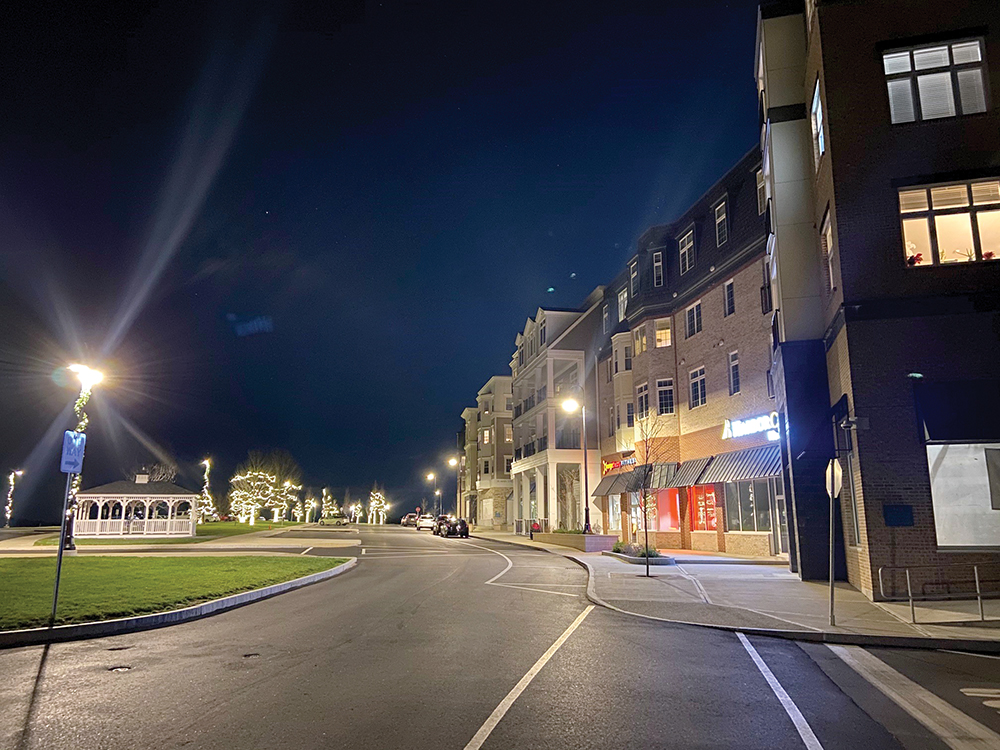
Main Street at Woodmont Commons. Courtesy photo.
Despite the pandemic, Londonderry, a town of just over 26,000 residents, is seeing a surge in development. A key project is the massive Woodmont Commons mixed-use project just off Exit 4 of Interstate 93. There’s also redevelopment of longstanding complexes like the Apple Tree Mall and a spike in business and industrial activity near Exit 5.
That spate of development is the result of decades of careful planning—as well as infrastructure investments, including new sewer-and-water infrastructure. Londonderry is capitalizing on its “sweet spot” location astride I-93 and a major airport in its backyard.
While some businesses have struggled because of COVID-19, “We’ve been very lucky in Londonderry because we haven’t seen a major shift or change as a result of the pandemic,” says Town Planner Colleen Mailloux. “In terms of projects submitted to us, we haven’t seen any slowdown on the development side of things.”
Booming Bedroom Community
Once renowned for its apple orchards and rural character, the community has managed to sustain that pastoral appeal while still building on its economic base, town officials say.
A major impetus for early growth was the construction of I-93 in the late 1950s and early ‘60s, when “suddenly Londonderry started to become a bedroom community for people commuting into Massachusetts,” says Town Manager Kevin H. Smith, himself a product of that migration.
Between 1960 and 1970, Londonderry’s population grew 118%, according to the NH Employment Security, Economic and Labor Market Information Bureau, followed by a hike of 154% over the next decade. Smith’s family was among those moving to Londonderry from southern Massachusetts in 1986, when he was a boy, seeking what others sought—“less taxes, a better quality of life, a place that felt like the country, a good school system,” he says.
But town officials anticipated what runaway growth would mean to the town and “held strong trying to have economic growth and preserve that rural character,” says Mailloux.
Conservation easements were put on many of the apple orchards and other open areas, overlay zoning was put on some commercial areas to limit growth, restrictions were put on the size of commercial buildings, and a growth management plan capped the number of housing developments that could be built in a single year, Smith says. Commerce was largely limited to the areas of the interstate, Routes 102 and 28, and the area near Manchester-Boston Regional Airport, which straddles Londonderry and Manchester in the northwest corner of town.
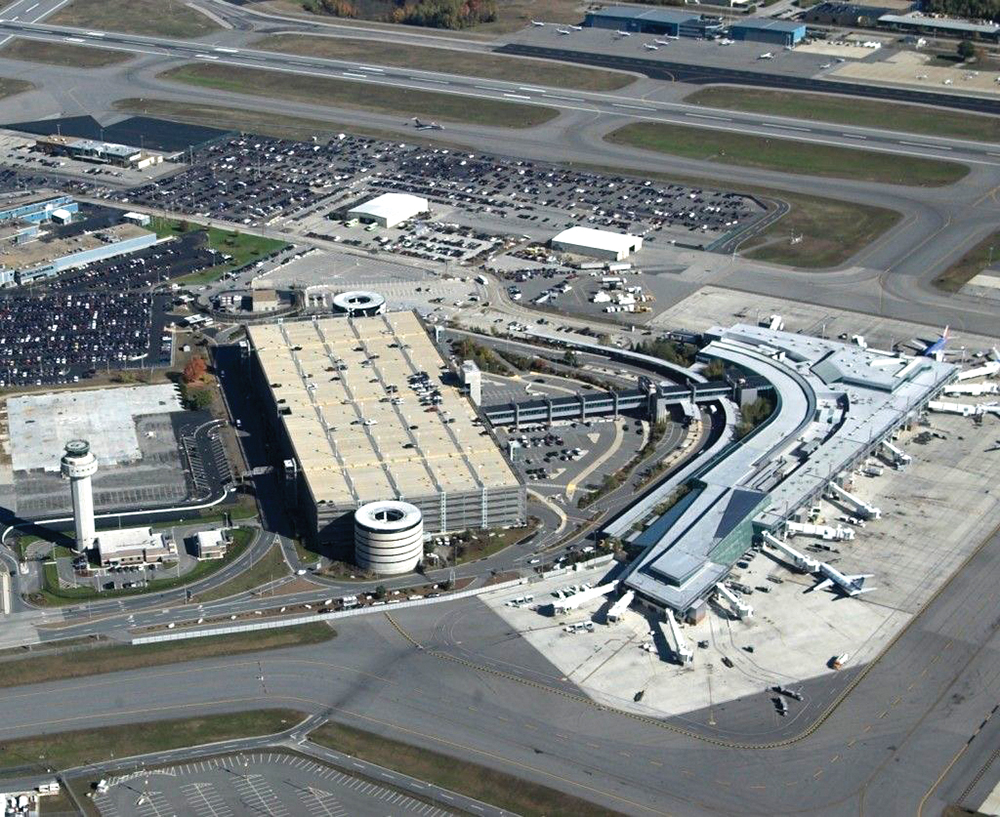
The Manchester-Boston Regional Airport. Courtesy of the town of Londonderry.
“It really had the desired effect,” Smith says. “If you look at population growth and commercial development between 2000 and 2010, it was almost nonexistent. That gave a chance for the community to catch up in terms of right-sizing itself so it had appropriate school space and the number of services on the town side that would be required.”
Economic Powerhouse Emerges
Today, “the commercial and industrial corridors are like a belt that goes around the north and south side while the residential middle has stayed the same, which I think people appreciate,” says Smith.
The Woodmont Commons project is situated on 600 acres on either side of Exit 4, with about 90 acres being developed, according to Michael Kettenbach, principal owner of Pillsbury Realty Development. Ground was broken last year.
Offering shops, parks, housing, and commercial and office space, the complex is expected to take years to be completed, with an estimated final cost of $750 million to $1 billion, Kettenbach says. “If you’re going to do it, go big.”
Already constructed are the 603 Brewery & Beer Hall, which Kettenbach says is doing so well it is running out of space, as well as 87 apartments that are fully leased. As many as 150 additional apartments may be built next year across from the current apartment building, he adds, in addition to 25 townhouses.
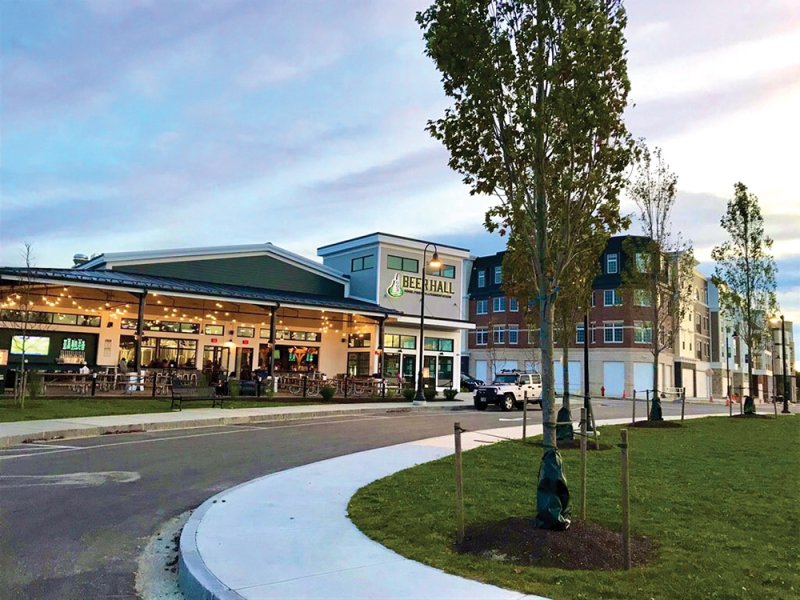
603 Brewery & Beer Hall at Woodmont Commons. Courtesy of the town of Londonderry.
Also planned is a 60,000-square-foot medical office building on Michel’s Way, as well as The Baldwin, a 270-unit life care center on the west side of the property (though under separate ownership purchased from Kettenbach).
Woodmont Commons is also giving Londonderry something it has never had: an economic “downtown,” complete with a Main Street. The historic center of town has been the area near the library and Town Hall on Mammoth Road, Mailloux says, but Londonderry has never had an economic center. “The reason they chose the name Main Street was that part of the vision of Woodmont was to create a downtown vision of Londonderry,” she adds. “The fact that the name ‘Main Street’ hadn’t been taken already speaks for itself.”
Kettenbach says his firm is getting a lot of demand for residential housing on the property, as well as for biomedical and light industrial facilities for the east side of I-93.
Meanwhile, two restaurants and a hotel withdrew their plans for the project because of the pandemic, he says, adding they may be back when the crisis is over. “It was not a major blow,” he says.
A little further west on Route 102, the 204,000-square-foot Apple Tree Mall—60% to 65% vacant just three years ago—has been purchased and undergone a roughly $4 million renovation, according to new owner George Vernet, manager of Vernco Apple.
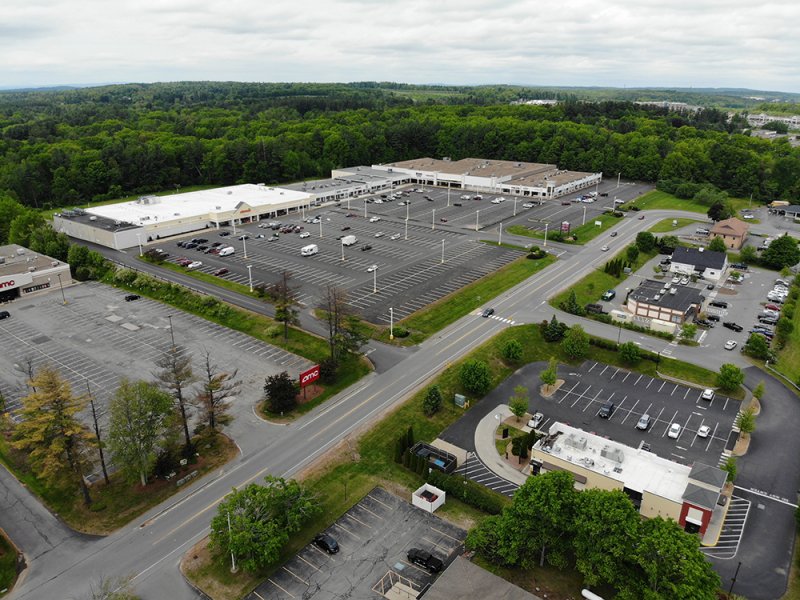
Aerial view of The Apple Tree Mall. Courtesy of Vernet Properties.
While Shaw’s supermarket anchored one end of the property, several tenants had moved away—including T.J. Maxx & HomeGoods, Goodwill and Lindt Chocolate—before Vernet repaved the parking lot, put on new roofs, hooked into town sewer and made other improvements. After attracting businesses like Planet Fitness, Lucciano’s Ristorante and Dollar Tree, the mall is about 95% occupied, Vernet says.
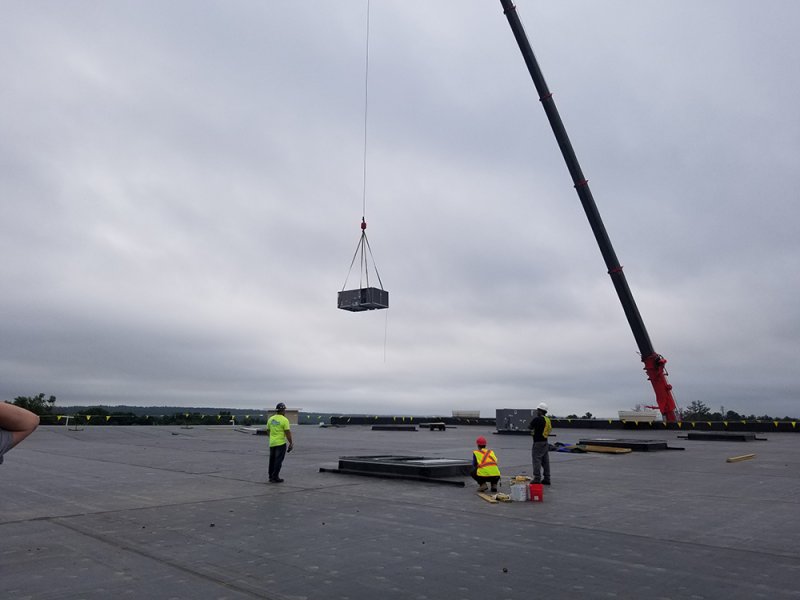
Installing new HVAC units at Planet Fitness in the Apple Tree Mall. Courtesy of Vernet Properties.
COVID Strikes
However, Londonderry has not been immune to the economic effects of the pandemic. Xtreme Craze, an indoor family fun center that opened in February 2019, was doing well until COVID struck and shut it down for five months. “It’s been devastating,” says owner Greg Hughes. “We had about 40 employees who were laid off.”
While Xtreme Craze reopened at the beginning of August, “we’re only realizing about 25% of what we expected from a revenue perspective,” Hughes says. “We’re just looking forward to getting to the other side of it. We’re just trying to survive.” He estimates Xtreme Craze welcomed between 40,000 and 45,000 visitors in 2019, but was on pace for just 7,000 to 8,000 in 2020.

Xtreme Craze Owner Greg Hughes, second from left, and his family in the inflatable park. Courtesy photo.
Hughes says the business has been hanging on thanks to the “understanding and generosity” of his landlord and bank. “If those two parties continue to work with us, we think we’re going to survive until the vaccines start to be distributed in the middle of next year, but we also need federal and state help because we’re in desperate shape.”

Arcade games at Xtreme Craze. Courtesy photo.
Town officials have been trying to help small businesses like Xtreme Craze and local restaurants that are suffering because of COVID, according to Smith, targeting $50,000 in state pandemic funding for them. In addition, says Mailloux, the town expedited administrative processes to grant temporary approval for restaurants to have outdoor seating.
The Airport Effect
Farther north, the commercial area off Exit 5 near the airport is also flourishing. The 2011 opening of an access road, Raymond J. Wieczorek Drive, that connects with the Everett Turnpike, and the 2015 opening of Pettengill Road, provided a gateway to some 1,000 acres of developable land just south of airport runways.
The airport has always been an economic driver in town, says Smith, but retail and office space had dominated the area until those road openings, when warehouse and distribution centers, as well as industrial operations, started moving in. Some 2 million square feet of commercial space has been added.
Among the firms in the area are Prime Source Foods, American Tire Distributors Warehouse, a newly expanded Coca-Cola Bottling Co., and Harvey Building Products.
Workforce housing projects are also underway in that northern part of town with the Residences at MacGregor Cut on Stonehenge Road and Wallace Farm on Bridle Path Lane offering 280 and 240 units respectively, according to Mailloux. Both projects, which include some income-restricted units, are being constructed in phases, with MacGregor Cut about 50% complete as well as three of Wallace Farm’s 10 buildings, she adds, noting that buildings from the first phases have been fully occupied for more than a year.
The airport area continues to attract office tenants, as well, with the Dubay Group being just one example. The engineer/planning/surveying group moved in late December from an 1,800-square-foot converted historic house in Windham to a 1980s-era, 5,000-square-foot office on Londonderry’s Harvey Road, transforming the building into a modern, open concept space geared toward collaboration. “We chose Londonderry for a lot of reasons. It’s more centrally located for all the projects we have in the state of New Hampshire. It’s easily accessible,” says owner Karl Dubay. “It’s a better location for the Manchester-Concord draw of talent.”

Sam Kauhl, project engineer, and Doug MacGuire, vice president of engineering, collaborating at The Dubay Group. Courtesy photo.
The firm is also involved in several ongoing construction projects in town, including a new Citizens Bank and ConvenientMD on Route 102, the 105-unit Sanborn Crossing senior housing complex on Sanborn Road, Wallace Farm and Hanafin Farms Condos on Old Nashua Road.
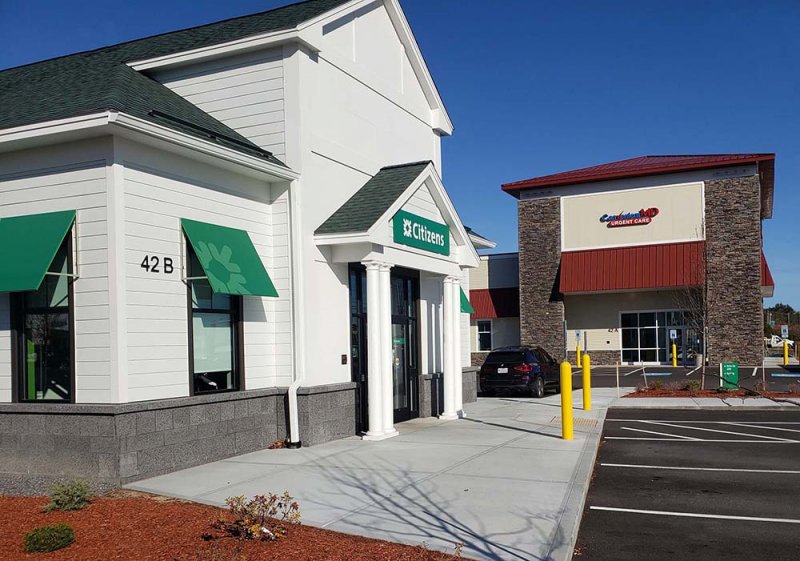
Citizens Bank and ConvenientMD on Route 102, a Dubay Group project. Courtesy photo.
Growing Pains
Town officials acknowledge Londonderry’s growth comes with some challenges, including the constant tension between preserving rural character and providing for economic growth, and addressing the issues posed by increased volumes of traffic. Smith notes the town has a traffic safety committee that meets regularly, but officials are considering a large-scale plan for road development and traffic mitigation.
He agrees with Mailloux that the town still has plenty of space for growth, particularly near the airport and Exit 5, and that Londonderry’s economic future looks rosy. “Geographically, Londonderry is really in the sweet spot of southern New Hampshire,” he says. “We’re the beneficiary of just a really good geographic location that has easy access to the interstate and a major airport, on top of having a great quality of life and amenities in town.”
Dubay agrees. “Londonderry is a great town to live in and do business in,” he says. “Many towns in New Hampshire ask what do they want to be like, and many used to say they’d like to be like Bedford. I think now people are going to be saying, ‘we want to be like Londonderry.’”
